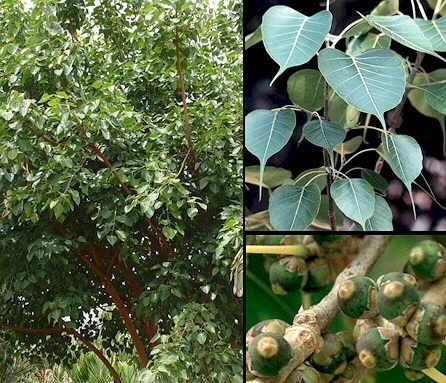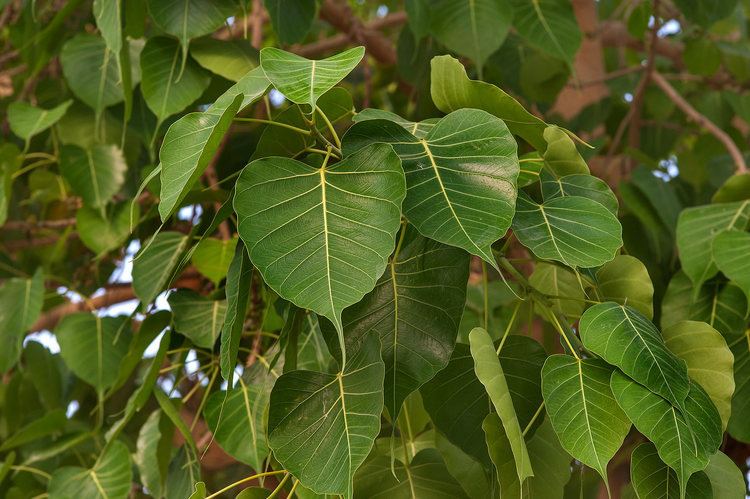Genus Ficus Rank Species Higher classification Fig | Scientific name Ficus religiosa | |
 | ||
Similar Fig, Moraceae, Ashoka tree, Indian bael, Holy Basil | ||
Ficus religiosa or sacred fig is a species of fig native to the Indian subcontinent, and Indochina. It belongs to the Moraceae, the fig or mulberry family. It is also known as the bodhi tree, pippala tree, peepul tree, peepal tree or ashwattha tree (in India and Nepal).
Contents
- Rooting cuttings in water ficus religiosa peepal tree part 1
- Description
- In religion
- Buddhism
- Hinduism
- Vernacular names
- Cultivation
- Uses
- References

Rooting cuttings in water ficus religiosa peepal tree part 1
Description

Ficus religiosa is a large dry season-deciduous or semi-evergreen tree up to 30 metres (98 ft) tall and with a trunk diameter of up to 3 metres (9.8 ft). The leaves are cordate in shape with a distinctive extended drip tip; they are 10–17 cm long and 8–12 cm broad, with a 6–10 cm petiole. The fruits are small figs 1–1.5 cm in diameter, green ripening to purple. The leaves of this tree move continuously even when the air around is still and no perceptible wind is blowing. This phenomenon can be explained due to the long leaf stalk and the broad leaf structure. However, religious minded people in Hindu/Buddhist religion attribute this movement of the leaves to the fact that "devas" or "gods" reside on these leaves and make it move continuously.
In religion

The Ficus religiosa tree is considered sacred by the followers of Hinduism, Jainism and Buddhism. In the Bhagavad Gita, Krishna says, "I am the Peepal tree among the trees, Narada among the sages, Chitraaratha among the Gandharvas, And sage Kapila among the Siddhas."
Buddhism

Gautama Buddha attained enlightenment (bodhi) while meditating underneath a Ficus religiosa. The site is in present-day Bodh Gaya in Bihar, India. The original tree was destroyed, and has been replaced several times. A branch of the original tree was rooted in Anuradhapura, Sri Lanka in 288 BCE and is known as Jaya Sri Maha Bodhi; it is the oldest flowering plant (angiosperm) in the world.

In Theravada Buddhist Southeast Asia, the tree's massive trunk is often the site of Buddhist or animist shrines. Not all Ficus religiosa can be called a Bodhi Tree. A Bodhi Tree must be able to trace its parent to another Bodhi Tree and the line goes on until the first Bodhi Tree under which Gautama is said to have gained enlightenment.
Hinduism
Sadhus (Hindu ascetics) still meditate beneath sacred fig trees, and Hindus do pradakshina (circumambulation, or meditative pacing) around the sacred fig tree as a mark of worship. Usually seven pradakshinas are done around the tree in the morning time chanting "vriksha rajaya namah", meaning "salutation to the king of trees." It claimed that the 27 stars (constellations) constituting 12 houses (rasis) and 9 planets are specifically represented precisely by 27 trees—one for each star. The Bodhi Tree is said to represent Pushya (Western star name γ, δ and θ Cancri in the Cancer constellation).
Plaksa is a possible Sanskrit term for Ficus religiosa. However, according to Macdonell and Keith (1912), it denotes the wavy-leaved fig tree (Ficus infectoria) instead. In Hindu texts, the Plaksa tree is associated with the source of the Sarasvati River. The Skanda Purana states that the Sarasvati originates from the water pot of Brahma flows from Plaksa on the Himalayas. According to Vamana Purana 32.1-4, the Sarasvati was rising from the Plaksa tree (Pipal tree). Plaksa Pra-sravana denotes the place where the Sarasvati appears. In the Rigveda Sutras, Plaksa Pra-sravana refers to the source of the Sarasvati.
Vernacular names
The Ficus religiosa tree is known by a wide range of vernacular names, including:
Cultivation
Ficus religiosa is grown by specialty tree plant nurseries for use as an ornamental tree, in gardens and parks in tropical and subtropical climates. Peepal trees are native to India and thrive in hot, humid weather. They prefer full sunlight and can grow in most soil types, though loam is the best. When planting, use soil with a pH of 7 or below. While it is possible for the plant to grow indoors in a pot, it grows best outside. Young peepal needs proper nourishment. It requires full sunlight and proper watering.
Uses
Ficus religiosa is used in traditional medicine for about 50 types of disorders including asthma, diabetes, diarrhea, epilepsy, gastric problems, inflammatory disorders, infectious and sexual disorders.
